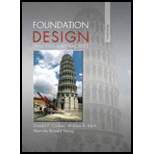
Concept explainers
A sample of soil has a volume of
Learn your wayIncludes step-by-step video

Chapter 3 Solutions
Foundation Design: Principles and Practices (3rd Edition)
Additional Engineering Textbook Solutions
Vector Mechanics For Engineers
Electric Circuits. (11th Edition)
Database Concepts (8th Edition)
Starting Out with Java: From Control Structures through Data Structures (4th Edition) (What's New in Computer Science)
Java: An Introduction to Problem Solving and Programming (8th Edition)
Java How to Program, Early Objects (11th Edition) (Deitel: How to Program)
- 7.2 An intersection has a four-timing-stage signal with the movements allowed in each timing stage and corresponding analysis and saturation flow rates shown in Table 7.7. Calculate the sum of the flow ratios for the critical lane groups.arrow_forward5.27 At a parking lot, vehicles arrive according to a Poisson process and are processed (parking fee collected) at a uniform deterministic rate at a single station. The mean arrival rate is 4.2 veh/min and the processing rate is 5 veh/min. Determine the average length of queue, the average time spent in the system, and the average waiting time in the queue. 5.28 Consider the parking lot and conditions described in Problem 5.27. If the rate at which vehicles are processed became exponentially distributed (instead of deterministic) with a mean processing rate of 5 veh/min, what would be the average length of queue, the average time spent in the system, and the average waiting time in the queue?arrow_forwardDetermine the heel and toe stresses and the factor of safeties for sliding and overturning for the gravity dam section shown in the figure below for the following loading conditions: - Horizontal earthquake (Kh) = 0.1 - Normal uplift pressure with gallery drain working - Silt deposit up to 30 m height - No wave pressure and no ice pressure -Unit weight of concrete = 2.4 Ton/m³ and unit weight of silty water = 1.4 Ton/m³ - Submerged weight of silt = 0.9 Ton/m³ - Coefficient of friction = 0.65 and angle of repose = 25° Solve this question with the presence of gallery and without gallery., discuss the issue in both cases.... 144 m E 4m W 8m 6m 8m7m 120marrow_forward
- On page 1, in the first body paragraph ("In the United States…to be smart."), edit the Kaya source so the Name of Web Page is "Fast Facts 2020: Demographics", the correct Name of the webpage.arrow_forward4.12 A 400 m vertical curve connects a -2.00% grade to a +4.00% grade. The P.I. is located at station 150 + 00 and elevation 60.00 m above sea level. A pipe is to be located at the low point on the vertical curve. The roadway at this point consists of two 3.6 m lanes with a normal crown slope of 2%. If the lowest point on the surface of the road- way must clear the pipe by 0.75 m, what is the station and maximum elevation of the pipe?arrow_forward=7.5 in., d1 = 1.5 in., b2 = 0.75 in., d2= 6.0 in., b3 = 3.0 in., and d3 = 2.0 in. Determine (a) the centroid location in inches from the bottom surface. Round off to two decimal places. M H b₂ y ... d₁ M by dy Xarrow_forward
- Vehicles arrive at a single park-entrance booth where a brochure is distributed. At 8 A.M., there are 20 vehicles in the queue and vehicles continue to arrive at the deterministic rate of λ(t) = 4.2 − 0.1t, where λ(t) is in vehicles per minute and t is in minutes after 8:00 A.M. From 8 A.M. until 8:10 A.M., vehicles are served at a constant deterministic rate of three per minute. Starting at 8:10 A.M., another brochure-distributing person is added and the brochure-service rate increases to six per minute (stillarrow_forwardVehicles arrive at a single park-entrance booth where a brochure is distributed. At 8 A.M., there are 20 vehicles in the queue and vehicles continue to arrive at the deterministic rate of λ(t) = 4.2 − 0.1t, where λ(t) is in vehicles per minute and t is in minutes after 8:00 A.M. From 8 A.M. until 8:10 A.M., vehicles are served at a constant deterministic rate of three per minute. Starting at 8:10 A.M., another brochure-distributing person is added and the brochure-service rate increases to six per minute (still at a single booth). Assuming D/D/1 queuing, determine the longest queue, the total delay from 8 A.M. until the queue dissipates; and the wait time of the 40th vehicle to arrive.arrow_forwardAt 8:00 A.M. there are 10 vehicles in a queue at a toll booth and vehicles are arriving at a rate of λ(t) = 6.9 − 0.2t. Beginning at 8 A.M., vehicles are being serviced at a rate of μ(t) = 2.1 + 0.3t [λ(t) and μ(t) are in vehicles per minute and t is in minutes after 8:00 A.M.]. Assuming D/D/1 queuing, what is the maximum queue length, and what would the total delay be from 8:00 A.M. until the queue clears?arrow_forward
- Introduction: Orifice and Free Flow Jet in Applied Fluid Mechanics' I need to introduction only for answerarrow_forwardcompute the load bearing capacity, displacement, stress distribution, tabulate the answersarrow_forwardcompute the load bearing capacity, displacement, and stress distribution, tabulate the answersarrow_forward
 Principles of Geotechnical Engineering (MindTap C...Civil EngineeringISBN:9781305970939Author:Braja M. Das, Khaled SobhanPublisher:Cengage Learning
Principles of Geotechnical Engineering (MindTap C...Civil EngineeringISBN:9781305970939Author:Braja M. Das, Khaled SobhanPublisher:Cengage Learning Fundamentals of Geotechnical Engineering (MindTap...Civil EngineeringISBN:9781305635180Author:Braja M. Das, Nagaratnam SivakuganPublisher:Cengage Learning
Fundamentals of Geotechnical Engineering (MindTap...Civil EngineeringISBN:9781305635180Author:Braja M. Das, Nagaratnam SivakuganPublisher:Cengage Learning Principles of Foundation Engineering (MindTap Cou...Civil EngineeringISBN:9781337705028Author:Braja M. Das, Nagaratnam SivakuganPublisher:Cengage Learning
Principles of Foundation Engineering (MindTap Cou...Civil EngineeringISBN:9781337705028Author:Braja M. Das, Nagaratnam SivakuganPublisher:Cengage Learning Principles of Foundation Engineering (MindTap Cou...Civil EngineeringISBN:9781305081550Author:Braja M. DasPublisher:Cengage Learning
Principles of Foundation Engineering (MindTap Cou...Civil EngineeringISBN:9781305081550Author:Braja M. DasPublisher:Cengage Learning Traffic and Highway EngineeringCivil EngineeringISBN:9781305156241Author:Garber, Nicholas J.Publisher:Cengage Learning
Traffic and Highway EngineeringCivil EngineeringISBN:9781305156241Author:Garber, Nicholas J.Publisher:Cengage Learning




